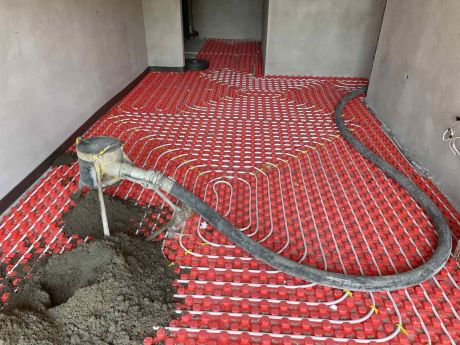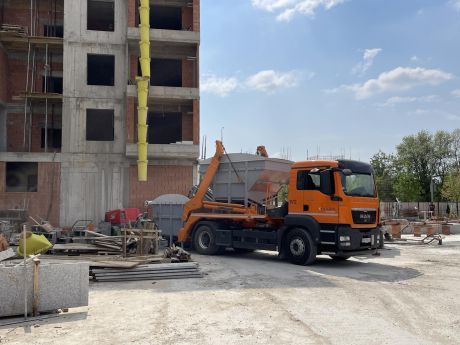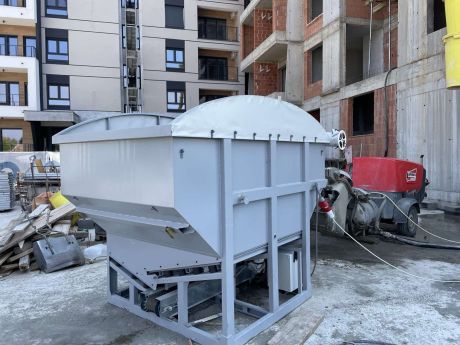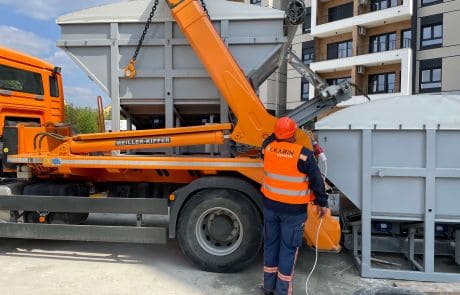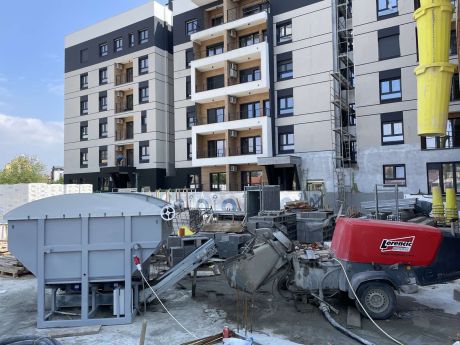CEMENT CONCRETE SCREED
Cement Concrete Screed
Cement concrete screed is an important element in building construction, providing a flat and strong base for various types of flooring. The traditional method of creating it requires skilled workers and specialized machines, while innovative approaches allow for a more efficient and controlled process. The introduction of automatic production and transportation of the mix directly from factory plants to construction sites significantly improves the quality and speeds up the process of creating cement concrete screeds.
How is it made?
The process of making a cement concrete screed involves several key steps:
- Material Preparation: Aggregates, cement, water, and polypropylene fibers are brought to the construction site. Aggregates are transported by dump trucks, while cement and fibers come in bags.
- Mixing Ingredients: In a specialized screed-making machine, the materials are manually added to the mixer. Two workers add the cement, water, aggregates, and fibers, resulting in a uniform and homogeneous mix after mixing.
- Transport and Installation: The mix is delivered to the installation site through pressurized hoses. The material is spread across the surface and leveled with special tools.
- Drying: The drying process takes approximately 1 cm per week but can be accelerated using drying machines. The screed moisture should not exceed 2% before the final finish is applied.
The machine-made cement screed is possible only in dry weather conditions, with temperatures above 10°C. In indoor spaces, the temperature should not be below -5°C.
Composition
The composition of materials according to the innovative solution includes the following components:
- Cement: The main binding material.
- Aggregates: Fractionated aggregate granules of 0-4 mm.
- Water: Necessary for the hydration process.
- Micro polypropylene fibers: Added to improve cohesion and reduce the risk of cracking.
- Chemical additives: Polycarboxylates and anionic surfactants improve workability and reduce segregation and water separation.
This specific composition allows for production in a concrete plant, where raw materials are automatically dosed and controlled. Factory production ensures material homogeneity and consistent quality. The material is transported in special machines with built-in dispensers, ensuring its consistency and optimal conditions until the installation site.
Innovative Approach by Karin Komerc
Karin Komerc MD offers an innovative approach in creating cement concrete screeds that significantly improves classical methods. The specific and innovative composition of the cement concrete screed allows for extended hydration time of four to five hours, enabling production in a concrete plant and transportation to the construction site. This approach includes the following advantages:
- Controlled Production: All ingredients are automatically dosed according to laboratory test results, ensuring consistent mix quality.
- Process Automation: Factory production is fully automated, with devices for automatic raw material proportioning. This allows full control of mix elements and reduces the possibility of errors.
- Efficient Transportation: The mix is transported in special containers that maintain its consistency and allow easy pouring at the construction site.
- Cost Reduction: Faster installation and reduced number of workers on site significantly lower construction costs.
- Environmental Standards: The use of certain mineral additives reduces CO2 emissions, fulfilling some requirements for obtaining LEED standards.
Thickness
The thickness of the screed affects its functionality and longevity. The thickness of the cement concrete screed can be adjusted to the specific requirements of the project and field needs. The standard thickness varies depending on the type of substrate and planned final finish:
- Minimum Thickness: The minimum thickness is around 3-4 cm.
- Medium Thickness: A thickness of 5-6 cm is recommended for all types of buildings.
- Maximum Thickness: For specific industrial applications, the thickness can be greater, depending on the load and project requirements.
This flexibility in thickness allows the cement screed to adapt to different types of substrates and final finishes, ensuring optimal strength and stability.
Drying
Drying the cement concrete screed is a significant step in the process, directly affecting its strength and the quality of the flooring work. Traditional methods required a long drying period, which often posed a challenge in construction projects. However, Karin Komerc MD’s innovative approach significantly reduces this time:
- Faster Drying: The innovative mix reduces drying time from 30-40 days to just 15 days.
- Moisture Control: During transport and installation, the mix is semi-dry with a moisture content of 30-40%, allowing for quick drying of the installed screed.
- Drying Quality: Controlled moisture during installation reduces the risk of cracking and ensures optimal conditions for final finishes.
- Drying Machines: If necessary, the drying process can be further accelerated using specialized drying machines.
This innovative approach not only speeds up work on the construction site but also reduces costs and the risk of damage during drying.


